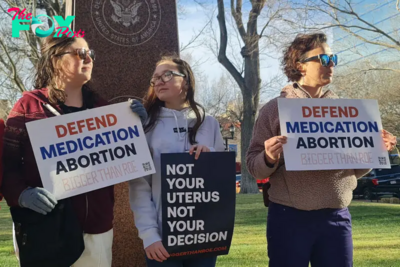Politics
Abortion drug access could be limited by Supreme Court − if the court decides anti-abortion doctors can, in fact, challenge the FDA
Who has the legal right to challenge decisions by the U.S. Food and Drug Administration? And should the moral umbrage of a group of anti-abortion rights doctors shift policy across the country, limiting women’s ability to get the widely used abortion drug mifepristone?
These are a few of the central questions that the Supreme Court fielded on March 26, 2024, during the oral arguments in FDA v. Alliance for Hippocratic Medicine. A group of doctors is challenging the FDA, saying that the federal agency’s decision allowing people to get mifepristone via telehealth, at up to 10 weeks of pregnancy, is causing some medical professionals harm.
Amy Lieberman, politics and society editor at The Conversation U.S., spoke with family law and reproductive justice scholars Naomi Cahn and Sonia Suter to better understand what’s behind the oral arguments before the Supreme Court – and how the court’s eventual decision, expected in June, could affect people’s ability to get abortions by using mifepristone, one of two drugs used for medication abortion.

What is this case about?
Sonia Suter: It’s about whether the FDA’s regulations for the use of mifepristone were appropriately loosened in 2016 and 2021. These changes generally make mifepristone more accessible by allowing people to have the medication prescribed via a telehealth visit and then getting the pill in the mail.
Naomi Cahn: That 2016 regulation also extended the time during which mifepristone could be prescribed, increasing it from seven to 10 weeks gestation. Medication abortions accounted for 63% of all abortions that occurred in the U.S. in 2023. This percentage has increased since the Supreme Court overturned the constitutional right to an abortion in 2022.
Why are these guidelines being challenged?
Suter: A group of doctors and medical associations that oppose abortion are challenging these guidelines and using this court case as a way, we believe, to limit the ability to get an abortion by using medication.
They challenged the drug’s initial approval by the FDA and the relaxed restrictions on how it is used. They claimed that the FDA exceeded its authority, did not rely on proper data and did not have adequate support from scientific studies for its decision that mifepristone could be safely prescribed. Their initial arguments, which the lower court accepted, would have banned mifepristone. But that decision was not upheld by the 5th Circuit Court.
Instead, the issues before the Supreme Court focus on whether the FDA should have expanded the use of mifepristone. Virtually all studies have shown that mifepristone is not dangerous, even with the relaxed conditions on its use.
What is the federal government’s central argument against these claims?
Cahn: The government is stating that the FDA appropriately reviewed all of the evidence and its decision was appropriate.
Indeed, the attorney representing the mifepristone manufacturer, Jessica Ellsworth, pointed out that the studies cited by the challengers have either been discredited or withdrawn because they were unreliable.
Another critical issue, as U.S. Solicitor General Elizabeth Prelogar said to the justices today, is whether the organization challenging this ruling actually has legal standing – the right to sue – to bring a lawsuit against the FDA.
Why is the question of who can sue the FDA important here?
Suter: Under U.S. law, you cannot succeed in court every time you are unhappy. The Supreme Court has ruled that the Constitution requires parties who bring suit in federal court to have “standing.” This means parties have to show that they have been injured in some tangible way or threatened with such an injury by the acts that are the basis of the lawsuit. In this case, a group of doctors morally opposed to abortion are saying they have been injured. Their claim is that with the changes in the FDA’s regulation of mifepristone prescriptions, patients will come to them in the emergency room, requiring medical care that violates these religious beliefs and causes them stress.
The government’s response is that the FDA is not making them do anything, including prescribe these pills or treat these patients. And there are conScience laws that say if the treatment is against a Health care provider’s beliefs, they do not need to provide that care. So the government asks: How are the doctors harmed here?

What is your impression from the justices, listening to these arguments?
Cahn: I was surprised by how much time the justices spent asking about legal standing and whether there was a direct enough connection between the plaintiffs and the FDA’s guidance.
What’s the potential impact of the court’s eventual ruling on this case?
Cahn: The court’s decision has implications for the whole FDA approval process as well as access to medication abortion, including through teleHealth and the mail. If the court rules for the doctors challenging the FDA, mifepristone would still be available, but access to it would be severely limited because people would need an in-person visit before they could get it.
-

 Politics9h ago
Politics9h agoWhy Trump Actually Needs Mexico
-

 Politics9h ago
Politics9h agoMan Convicted of Killing Laken Riley Sentenced to Life in Prison Without Parole
-

 Politics15h ago
Politics15h agoHow the Biden Administration Protected Abortion Pill Access—and What Trump Could Do Next
-

 Politics15h ago
Politics15h agoWhy Trump’s Tariffs Could Raise Grocery Prices
-

 Politics1d ago
Politics1d agoThe First Trans Member of Congress Expected Pushback Like Mace’s Bathroom Rule
-

 Politics1d ago
Politics1d agoNew York Prosecutors Oppose Dismissing Trump’s Hush Money Conviction
-

 Politics1d ago
Politics1d agoWhite House Christmas Tree Is a Symbol of Resilience for Hurricane-Hit North Carolina Farms
-

 Politics2d ago
Politics2d agoHakeem Jeffries Wins Reelection as House Democratic Leader Despite Party’s Losses




















